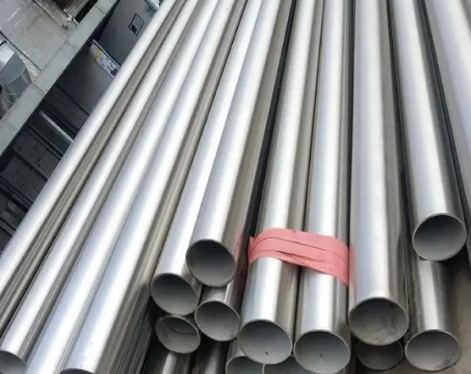304 stainless steel pipes are well known for their durability and resistance to corrosion, but they are not completely immune to rust. If they are handled or stored carelessly, rust spots can still appear. With the right approach, however, these pipes can stay in excellent condition for years.
Seamless stainless steel pipe refers to steel pipe formed through processes such as extrusion, piercing, or rolling, without weld seams. Its material is not limited to 304; it can also be various stainless steel grades such as 304, 316, 321, and 310S.
1. Protective Packaging Layer for Steel Pipes
Most 304 stainless steel pipes are shipped with a protective coating or plastic wrap. This is not just for show—it helps keep moisture, dust, and other contaminants away from the surface. When moving or unloading pipes, it’s important to avoid tearing or scratching this layer. Even a small scratch can become a weak spot where rust starts. If the original wrap is damaged, a temporary cover such as a plastic sheet or waterproof cloth can help protect the pipes until permanent storage is arranged. In practice, it also helps to lift pipes carefully rather than dragging them across the floor, especially on rough surfaces.
2. Choosing a Suitable Storage Location
A suitable storage location for stainless steel pipes should be clean, well-drained, and free from nearby factories or mines that produce harmful gases or dust. In the warehouse, steel pipes should not be stored with materials that easily corrode pipes, such as acids, alkalis, salts, or cement. Different models should also be stored separately to avoid confusion and contact corrosion.
Pipes must be covered and padded. Some thin-walled pipes, or those that are expensive and easily corroded, still need to be stored in a warehouse. The warehouse should be selected based on geographical conditions, usually a standard enclosed warehouse, that is, a warehouse with a roof, walls, tight doors and windows, and ventilation devices. The warehouse environment requires adequate ventilation on sunny days and can be closed to prevent moisture on rainy days.

3. Keep the warehouse clean and strengthen material maintenance.
Before storing 304 stainless steel pipes, care should be taken to prevent rain or impurities from entering. Materials that have been rained on or soiled should be cleaned using methods appropriate to their properties. For high-hardness materials, a wire brush can be used; for low-hardness materials, cloth or cotton can be used. After storage, regular inspections are necessary. If rust is found, the rust layer should be removed promptly. Generally, stainless steel welded pipes do not need oiling after cleaning. However, for thin-walled stainless steel pipes and alloy steel pipes, both the inner and outer surfaces should be coated with anti-rust oil after rust removal before storage. For severely rusted pipes, do not store them for too long after rust removal; use them as soon as possible.
4. Proper Stacking
The principle of stacking stainless steel pipe products is to ensure stable and safe stacking, and to stack them according to type and specification to prevent confusion and corrosion. This also facilitates easy retri.
The above covers how to store 304 stainless steel pipes. Storing pipes requires outer packaging, a suitable storage area, and proper stacking according to type and specification. In addition, maintaining a clean warehouse and strengthening material maintenance are also important. As long as you pay attention to these points, there should be little to worry about in storing 304 stainless steel pipes.
Seamless stainless steel pipe refers to steel pipe formed through processes such as extrusion, piercing, or rolling, without weld seams. Its material is not limited to 304; it can also be various stainless steel grades such as 304, 316, 321, and 310S.
1. Protective Packaging Layer for Steel Pipes
Most 304 stainless steel pipes are shipped with a protective coating or plastic wrap. This is not just for show—it helps keep moisture, dust, and other contaminants away from the surface. When moving or unloading pipes, it’s important to avoid tearing or scratching this layer. Even a small scratch can become a weak spot where rust starts. If the original wrap is damaged, a temporary cover such as a plastic sheet or waterproof cloth can help protect the pipes until permanent storage is arranged. In practice, it also helps to lift pipes carefully rather than dragging them across the floor, especially on rough surfaces.
2. Choosing a Suitable Storage Location
A suitable storage location for stainless steel pipes should be clean, well-drained, and free from nearby factories or mines that produce harmful gases or dust. In the warehouse, steel pipes should not be stored with materials that easily corrode pipes, such as acids, alkalis, salts, or cement. Different models should also be stored separately to avoid confusion and contact corrosion.
Pipes must be covered and padded. Some thin-walled pipes, or those that are expensive and easily corroded, still need to be stored in a warehouse. The warehouse should be selected based on geographical conditions, usually a standard enclosed warehouse, that is, a warehouse with a roof, walls, tight doors and windows, and ventilation devices. The warehouse environment requires adequate ventilation on sunny days and can be closed to prevent moisture on rainy days.

3. Keep the warehouse clean and strengthen material maintenance.
Before storing 304 stainless steel pipes, care should be taken to prevent rain or impurities from entering. Materials that have been rained on or soiled should be cleaned using methods appropriate to their properties. For high-hardness materials, a wire brush can be used; for low-hardness materials, cloth or cotton can be used. After storage, regular inspections are necessary. If rust is found, the rust layer should be removed promptly. Generally, stainless steel welded pipes do not need oiling after cleaning. However, for thin-walled stainless steel pipes and alloy steel pipes, both the inner and outer surfaces should be coated with anti-rust oil after rust removal before storage. For severely rusted pipes, do not store them for too long after rust removal; use them as soon as possible.
4. Proper Stacking
The principle of stacking stainless steel pipe products is to ensure stable and safe stacking, and to stack them according to type and specification to prevent confusion and corrosion. This also facilitates easy retri.
The above covers how to store 304 stainless steel pipes. Storing pipes requires outer packaging, a suitable storage area, and proper stacking according to type and specification. In addition, maintaining a clean warehouse and strengthening material maintenance are also important. As long as you pay attention to these points, there should be little to worry about in storing 304 stainless steel pipes.









